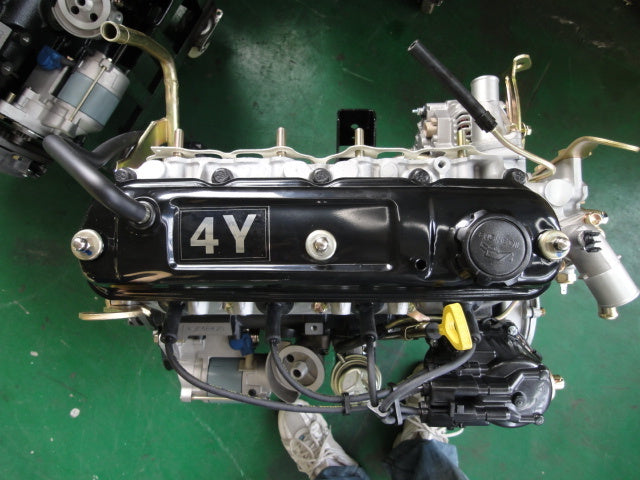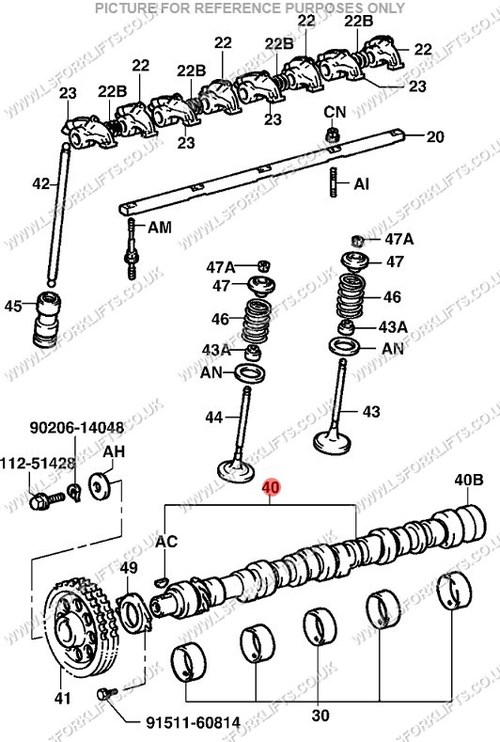What Makes the 4Y Engine Stand Out Among Other Automotive Engines
Why the Engine Is the Ideal Selection for Efficiency and Performance in Your Vehicle
The engine continues to be a critical component in automotive style, largely due to its substantial influence on both performance and effectiveness. As developments in modern technology enable smaller sized engines to deliver amazing power while enhancing gas economy, the combination of attributes such as turbocharging and crossbreed systems comes to be increasingly important. These innovations not only improve driving experience yet also address ecological problems. The inquiry arises: just how do these aspects coalesce to redefine our understanding of auto performance? Exploring this balance exposes deeper understandings right into the future of engine style.
Recognizing Engine Types
Comprehending the various kinds of engines is crucial for enhancing performance and effectiveness in automobile layout. The main engine kinds consist of inner combustion engines (ICE), electric engines, and crossbreed systems, each offering distinctive benefits and limitations.
Interior combustion engines, which can be further classified into gas and diesel variants, depend on the burning of fuel to create power. Gas engines generally give greater RPMs and much better acceleration, while diesel engines are understood for their torque and fuel efficiency, making them excellent for sturdy applications.
Electric engines, on the various other hand, utilize electric motors powered by batteries or fuel cells. They provide immediate torque distribution, causing smooth acceleration and reduced exhausts. The efficiency of electric engines is substantially greater than that of ICEs, making them a popular selection for eco-conscious customers.
Hybrid systems integrate both interior combustion and electrical engines, leveraging the strengths of both modern technologies. They enhance gas intake by utilizing electric power at reduced rates and changing to gas or diesel for higher rates or larger loads.
Selecting the appropriate engine kind is necessary for achieving desired performance metrics and environmental sustainability in modern-day auto engineering.
The Impact of Engine Size
Engine dimension frequently plays a pivotal duty in determining a vehicle's efficiency and performance. Typically determined in litres or cubic centimeters, engine dimension directly influences the power output and torque qualities of an automobile.
However, enhanced engine size typically associates with diminished gas performance. Bigger engines take in even more gas, resulting in higher discharges and functional expenses. Producers need to balance the demand for power with the need for gas economic climate. Smaller engines can deliver appropriate performance for daily driving while promoting better efficiency, making them a preferred option in small and mid-size automobiles.
Furthermore, innovations in engine layout, such as turbocharging and direct gas shot, allow smaller sized engines to accomplish power levels comparable to their bigger equivalents. This trend stresses the importance of not entirely focusing on engine dimension but additionally considering general vehicle layout and technology (4y engine). Ultimately, the influence of engine dimension on efficiency and efficiency highlights the requirement for consumers to evaluate their certain driving choices and requirements when selecting an automobile
Advanced Engine Technologies
Innovations in engine technologies have significantly improved the landscape of vehicle performance and effectiveness, building upon the fundamental principles developed by engine dimension. Significantly, innovations such as turbocharging and straight fuel shot have allowed smaller engines to supply power degrees formerly linked with larger equivalents. Turbochargers compress air going into the engine, enabling boosted power result without a corresponding boost in engine size, while straight injection enhances gas shipment, boosting combustion performance.
Furthermore, variable shutoff timing systems have actually become an important innovation, enabling engines to readjust shutoff operation based upon driving problems. This versatility boosts both performance throughout acceleration and gas performance throughout travelling. Hybrid and electric engine innovations even more illustrate the change in automotive design, integrating standard interior burning engines with electric motors to make the check this most of efficiency while decreasing emissions.
Additionally, advancements in products science have led to lighter, a lot more long lasting engine parts, further enhancing efficiency and long life. The assimilation of sophisticated electronics and engine control devices additionally permits for real-time adjustments, use this link making sure optimal performance throughout various problems. Jointly, these sophisticated engine technologies not only improve lorry efficiency however additionally add to an extra sustainable automobile future, demonstrating the ongoing advancement of engine style.
Harmonizing Power and Efficiency
Striking an equilibrium between power and performance is crucial in contemporary auto layout as suppliers look for to meet progressively strict exhausts guidelines while satisfying customer demand for efficiency (4y engine). The difficulty hinges on enhancing engine qualities to provide durable power output without compromising gas economic climate
To achieve this equilibrium, engineers employ various techniques, such as turbocharging, which boosts engine power forcibly in even more air, allowing for a smaller engine variation that improves gas efficiency. Variable shutoff find timing innovations also play a substantial function, allowing engines to adjust their performance attributes based upon driving conditions, therefore improving both power and effectiveness.
Furthermore, advancements in materials and manufacturing methods have actually caused lighter engine parts, which reduce overall automobile weight and improve fuel performance without endangering power. Hybrid innovations have actually likewise emerged as a practical service, combining standard internal combustion engines with electric powertrains to offer a boost in efficiency while keeping lower emissions.

Future Patterns in Engine Design

Moreover, the advancement of sophisticated products, such as high-strength alloys and lightweight composites, is readied to change engine parts. These products not just minimize weight however likewise boost thermal effectiveness, thus maximizing performance. Furthermore, producers are checking out variable compression proportions, permitting engines to adapt to different driving conditions, improving both power result and fuel economic climate.
Further, the surge of expert system and artificial intelligence in engine design is making it possible for anticipating upkeep and real-time efficiency optimization. This modern technology can cause engines that self-adjust for maximum effectiveness based upon driving patterns.

Conclusion
In conclusion, the engine offers as a vital part in attaining optimal efficiency and performance in modern-day vehicles. The interplay between engine dimension and design continues to advance, driving innovations that stabilize exhilarating efficiency with environmental sustainability.
Furthermore, innovations in engine design, such as turbocharging and direct gas shot, permit smaller sized engines to attain power levels similar to their bigger equivalents.Advancements in engine technologies have considerably reshaped the landscape of vehicle performance and efficiency, building upon the foundational ideas established by engine size. Turbochargers press air entering the engine, allowing for enhanced power outcome without a matching increase in engine size, while straight shot maximizes gas shipment, boosting combustion effectiveness.
Hybrid and electric engine innovations further illustrate the shift in automotive layout, incorporating standard inner burning engines with electric motors to maximize efficiency while lowering emissions.
Collectively, these innovative engine innovations not just enhance car performance yet likewise contribute to an extra lasting vehicle future, showing the ongoing development of engine design. (4y engine)